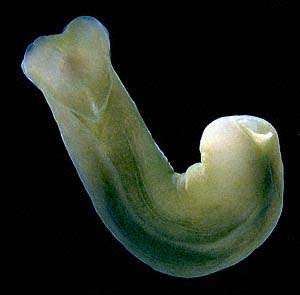
Phanerophthalmus smaragdinus
(Ruppell & Leuckart, 1828)
Order: CEPHALASPIDEA
Family: Smaragdinellidae
DISTRIBUTION
Tropical Indo-West Pacific.
PHOTO
Noumea, New Caledonia, Oct, 1988. 25mm long alive. PHOTO: Bill Rudman.
Phanerophthalmus has a remarkable resemblance to an aglajid, and until quite recently was considered to be a member of that family. The headshield is proportionally very small and the posterior shield and enclosed mantle cavity is an equally small remnant at the posterior end of the body (on the right in the photo). The round opening that can be seen at the posterior end is in fact the "exhalant siphon" from the mantle cavity. The small plate-like shell is partially enclosed in the mantle tissue.
Despite looking like an aglajid from the outside, a quick look at the gut shows that this animal is a herbivore closely related to Haminoea, with a similar radula and gizzard, with three grinding chitinous plates.
Reference:
• Rudman,W.B., 1972. The herbivorous opisthobranch genera Phanerophthalmus A.Adams and Smaragdinella A.Adams. Journal of Natural History, 5: 647-675.
Rudman, W.B., 1998 (December 18) Phanerophthalmus smaragdinus (Ruppell & Leuckart, 1828). [In] Sea Slug Forum. Australian Museum, Sydney. Available from http://www.seaslugforum.net/find/phansmar
Related messages
Colour variation in Phanerophthalmus from Reunion.
October 12, 2007
From: Hugues Flodrops
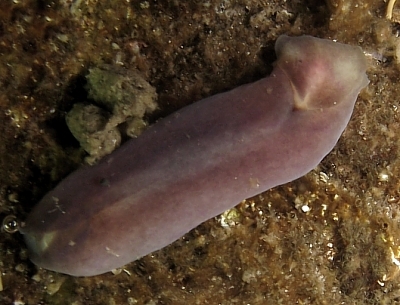
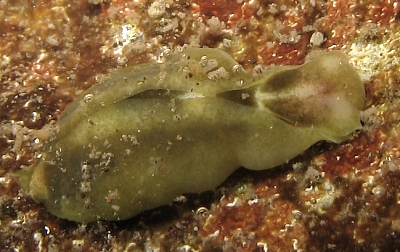
Concerning message #15879:
Dear Bill,
Here are three pictures of probably Phanerophthalmus smaragdinus from the same pool. The colour variation from pink to green and brown-green maybe result of the algae it's feeding on.
Initially, I named the first one (grey-pink color) Chelidonura flavolobata and then Phanerophthalmus albocollaris. I don't really understand what is the very conspicious white at the end of the head? My best guess now it is Phanerophthalmus smaragdinus. Can you say if P. smaragdinus and P. albocollaris are really distinct? All the specimens are about 25-30 mm in length.
Locality: Etang-Salé Permanent Pool, 1 metre, Reunion Island, Indian Ocean, 25 september 2007, By night. Length: 25 mm. Photographer: Hugues Flodrops.
Thanks again and best regards.
Hugues.
hugues.flodrops@wanadoo.fr
Flodrops, H., 2007 (Oct 12) Colour variation in Phanerophthalmus from Reunion.. [Message in] Sea Slug Forum. Australian Museum, Sydney. Available from http://www.seaslugforum.net/find/20828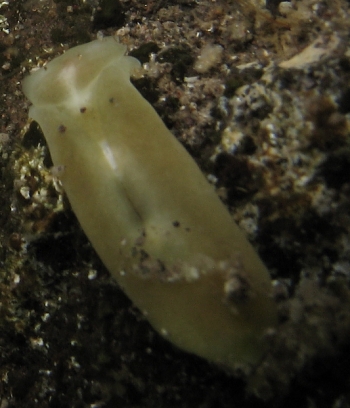
Dear Hugues,
I can't add much to my anatomical study of Phanerophthalmus in 1972. Certainly it seems to vary in colour from green or yellow to the greyish colour of one of your animals. Phanerophthalmus has a remarkable similarity in shape to an aglajid and for many years was considered a member of that family despite the fact that its internal anatomy was clearly that of a haminoeid.
Atsushi Ono's message [#1468] shows the colour variation as well and he includes an animal with a white W mark around the posterior edge of the head shield, which is the main distinguishing feature of P. albocollaris. I suspect P. albocollaris is a colour form of P. smaragdinus but unfortunately, synonymising species [that is deciding they are not different] is much more difficult than making a new species, as you have to make detailed anatomical comparisons, look at variation in colour and shape etc, etc. Of course these are the things that should have been done when the new species was proposed, but unfortunately it is often not done. As I have said on the species Fact Sheet, P. albocollaris was described from a single 3 mm long specimen, so we can't really say whether its distinct colour pattern is because it is distinct or because it is a juvenile variation of P. smaragdinus. A few other species of Phanerophthalmus have been described but there seems to be no easy way to distinguish them from P. smaragdinus on what we know of their colour and anatomy.
I can't really say if the colour of these animals is a result of the colour of their algal food. In sacoglossans the colour is often affected by the colour of the chloroplasts they acquire from their food, but in haminoeids the food is crushed and digested and chloroplasts are not retained, so they would need to have a mechanism to retain colour pigments from their food. The first step would be to find just what algae they eat. At present we don't know if they are specialist feeders or not.
-
Rudman,W.B., 1972. The herbivorous opisthobranch genera Phanerophthalmus A.Adams and Smaragdinella A.Adams. Journal of Natural History, 5: 647-675.
Best wishes,
Bill Rudman
Another grass bed find from the Philippines
July 10, 2006
From: Charles Raabe
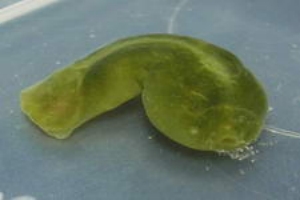
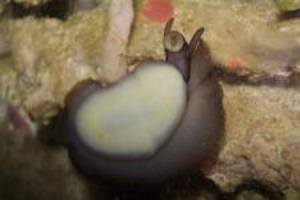
This is yet another grass bed find for me, while I haven't actually seen a shell, it feels like it may have a small shell. I am assuming it is an algae eater going by its rasping mouth parts. An identification would be nice if possible. Thank you.
Locality: Mactan Island, 2 feet, Philippines, Indo Pacific, 14 June 2006, sea grass bed. Length: 1.5 inches. Photographer: Charles Raabe.
Charles Raabe
charlesr1958@pacific.net.ph
Raabe, C., 2006 (Jul 10) Another grass bed find from the Philippines. [Message in] Sea Slug Forum. Australian Museum, Sydney. Available from http://www.seaslugforum.net/find/16968Dear Chuck,
The green animal is Phanerophthalmus smaragdinus, a primitive herbivorous slug with an internal shell. The grey-black animal in your lower photo is quite different. It is a marine snail, with a flattened shell partially hidden by folds of skin on its back. Have a look at the Scutus page for more information.
Best wishes,
Bill Rudman
Phanerophthalmus smaragdinus from Reunion Island
February 23, 2006
From: Philibert Bidgrain
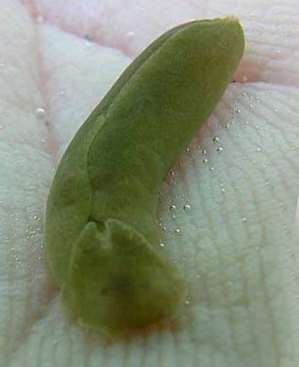
Dear Bill,
Reunion Island sea slugs.
In Reunion Island we have observed one specimen of this species in a lagoon. I think it could be Phanerophthalmus smaragdinus. What's your opinion?
Locality: Saint Pierre, 1 m, Reunion Island, Indian ocean, november 2005, lagoon. Length: 20 mm. Photographer: Alain Barrére.
Best Regards
Philibert Bidgrain
http://vieoceane.free.fr/runseaslug/indexslug.htm
pbidgrain@yahoo.fr
Bidgrain, P., 2006 (Feb 23) Phanerophthalmus smaragdinus from Reunion Island. [Message in] Sea Slug Forum. Australian Museum, Sydney. Available from http://www.seaslugforum.net/find/15879Dear Philibert,
Congratulations to Alain for his photographic technique. I have tried to photograph Phanerophthalmus smaragdinus many times without great success. It is usually half covered in sand - or at least with some grit - in the field, and does not like crawling on smooth surfaces in the lab. I never thought to try photographing it on my hand! This species is a great example of just how often in the Cephalaspidea, shelled species have evolved into slugs independently. In fact Phanerophthalmus was considered for many years to be a member of the Aglajidae. However its internal anatomy clearly shows that its ancestry is amongst the haminoeids.
Best wishes,
Bill Rudman
Phanerophthalmus from Japan
November 1, 1999
From: Atsushi Ono
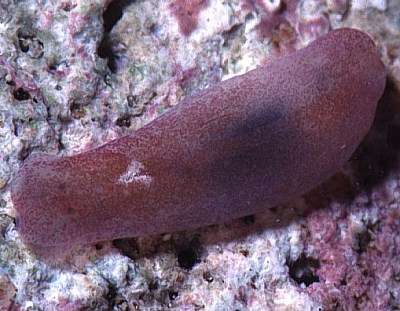
Dear Bill
I have found 4 color variations of Phaneropthalmus spp at Kerama Is. [near Okinawa]. One is green and I think this is P. smaragdinus
which I haven't sent a photo of because it is in my book
The three individuals in the attached photos are maybe the same species, but I hope you can check them for me.
UPPER RIGHT: I think this is a juvenile, 5mm long, at 5m depth. This was found underside of dead coral. Its body color is dark pink, tip of head shield is white.
LOWER LEFT: This is 15-20mm long, at 3m depth, I have seen 3 individuals. This body color is dark brown, tip of head shield is white little. This has two round light patches on its head shield. I show this in my book.
LOWER RIGHT: This is similar to P. smaragdinus. Body color is dark green, 20mm long, at 3m depth.
Atsushi Ono
ononini@cosmos.ne.jp
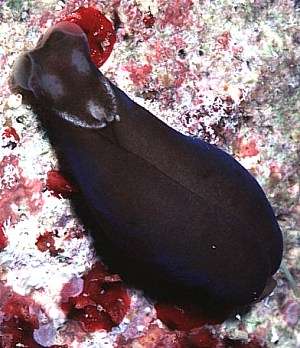
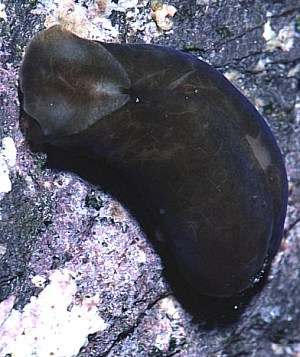
Dear Atsushi,
I suspect that Phanerophthalmus gets some of its body colour from the algae it is feeding on, which could explain some of the colour variation from pink to dark green. I am not sure though about the black forms. The white edging at the posterior tip of the headshield in both pink and black animals does suggest they are the same species. I have seen small pink animals and larger ones ranging from a translucent pale green to a dark greenish-black but never pure black ones like the one in your photo.
The only way to be sure if they are the same species is to have a look their anatomy to see if we can find any differences in the shape of their teeth or gizzard plates.
Best wishes,
Bill Rudman.
